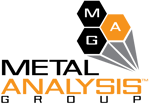EXPERT-APPROVED: XRF ALLOY
Expert-Approved XRF Analyzers for Scrap Metal Recycling from Metal Analysis Group
Enhancing Efficiency in Metal Recycling: The Role of Handheld XRF Analyzers
Metal recycling plays a crucial role in sustainability efforts worldwide, but the process of identifying and sorting scrap metal can be time-consuming and labor-intensive. However, with advancements in technology, particularly handheld X-ray Fluorescence (XRF) analyzers, the task of scrap metal identification and sorting has become significantly faster and more efficient. Let's explore the benefits and applications of these cutting-edge devices in metal recycling.
Streamlining Scrap Metal Identification
Traditionally, scrap metal identification and sorting could take days or even months, depending on the size of the pile and the complexity of the materials involved. However, with handheld XRF analyzers, the process is streamlined to a matter of seconds. These devices utilize X-ray spectrometer analysis to detect and identify a wide range of metals and alloys, including but not limited to:
- Aluminum
- Magnesium
- Titanium
- Cobalt
- Nickel
- Copper
- Zinc
- Precious metals
- Rare-earth metals
- Niobium
- Lead
- Tin
This comprehensive list covers the majority of metals encountered in scrap metal recycling, making handheld XRF analyzers indispensable tools for rapid and accurate material identification.
Advantages of XRF Analyzers for Scrap Sorting
The advantages of using handheld XRF analyzers for scrap sorting are manifold:
-
Speed and Efficiency: With rapid material identification capabilities, XRF analyzers significantly reduce sorting time, allowing for faster processing of scrap metal.
-
Accuracy: These devices provide precise elemental analysis, ensuring that each metal component is correctly identified and sorted according to its alloy grade.
-
Portability: Lightweight and portable designs enable easy transportation of XRF analyzers to various scrap metal sites, facilitating on-the-spot analysis and decision-making.
-
Durability: With features such as dust and waterproof protection, XRF analyzers are built to withstand harsh environmental conditions commonly encountered in recycling facilities.
-
Cost-Effectiveness: Investing in XRF analyzers for scrap sorting translates to long-term cost savings by optimizing operational efficiency and reducing labor expenses.
Conclusion
In conclusion, handheld XRF analyzers have revolutionized the scrap metal recycling industry by offering unparalleled speed, accuracy, and efficiency in material identification and sorting. Companies like Metal Analysis Group continue to innovate, providing advanced solutions that meet the evolving needs of the recycling market. By harnessing the power of XRF technology, metal recyclers can enhance their operations, improve resource utilization, and contribute to a more sustainable future.
